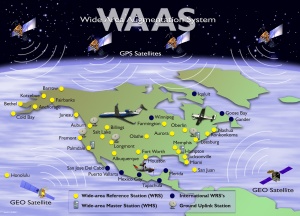If you wish to contribute or participate in the discussions about articles you are invited to contact the Editor
WAAS Architecture: Difference between revisions
(Created page with "{{Article Infobox2 |Category=WAAS |Title={{PAGENAME}} |Authors=GMV. |Level=Basic |YearOfPublication=2011 |Logo=GMV }} The Wide Area Augmentation System ([[Work in Progress:WAAS ...") |
Rui.Pereira (talk | contribs) m (moved Work in Progress:WAAS Architecture to WAAS Architecture) |
(No difference)
| |
Revision as of 07:18, 5 August 2011
| WAAS | |
|---|---|
| Title | WAAS Architecture |
| Author(s) | GMV. |
| Level | Basic |
| Year of Publication | 2011 |
The Wide Area Augmentation System (WAAS) is the United States Satellite Based Augmentation System. The programme, started in 1992, is being carried out by the Federal Aviation Agency (FAA)[1] and is specially developed for the civil aviation community.[2] The system, which was declared operational in late 2003,[3] currently supports thousands of aircraft instrument approaches in more than one thousand airports in USA and Canada.[4] WAAS service area includes CONUS, Alaska, Canada and Mexico.[5] The WAAS programme is continuously in evolution; two development phases have been already covered, a third is in progress, and there are plans to improve the capability of the system in parallel with the evolution of the SBAS standards towards a dual-frequency augmentation service.[6]
WAAS Architecture
WAAS works by processing GPS data collected by a network of reference stations to generate the SBAS message which is uploaded to the GEO satellites. The GEO satellites broadcast this information to the user receivers, which compute the aircraft positioning and inform on potential alert messages.[7]
The main layers of WAAS architecture are:
- WAAS Ground Segment: The WAAS ground segment encompasses reference stations (Wide-area Reference Stations, WRS), master stations (WAAS Master Stations, WMS), uplink stations (Ground Uplink Stations, GUS), and operational centers. The signals from GPS satellites are collected by the many widely-spaced Wide-area Reference Stations (WRS). The WRS collected data are forwarded to the WAAS Master Station (WMS) via a terrestrial communications network. At the WMS, the WAAS augmentation messages are generated, and send them to two pairs of Ground Uplink Stations (GUS), which then transmit to navigation payloads on Geostationary communications satellites (WAAS Space segment) for rebroadcast to the User segment.[7]
- WAAS Space Segment: The space segment is composed of multiple geosynchronous communication satellites (GEO) with navigation payloads that broadcast the WAAS augmentation messages generated by the WMS to the User segment.
- WAAS User Segment: The user segment is usually any aircraft with approved WAAS avionics, i.e. with a WAAS-enabled GPS receiver that used the WAAS corrections from the Space segment. The WAAS user equipment shall be compliant (certified) against several standards, i.e. RTCA MOPS DO 229 (see article SBAS Standards).
Notes
References
- ^ Navigation Services - History - Satellite Navigation, FAA.
- ^ Navigation Services - Wide Area Augmentation System (WAAS), FAA.
- ^ Wide Area Differential GPS (WADGPS), Stanford University
- ^ GNSS - GPS/WAAS Approaches, Federal Aviation Agency (FAA).
- ^ WAAS Service Expanded into Canada and Mexico, September 28, 2007, Federal Aviation Agency (FAA).
- ^ SatNav News, Vol. 33, March 2008, Federal Aviation Agency (FAA).
- ^ a b FAA WAAS: How it works

